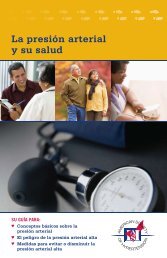2010 Annual Scientific Meeting and Exposition 2010 Annual ...
2010 Annual Scientific Meeting and Exposition 2010 Annual ...
2010 Annual Scientific Meeting and Exposition 2010 Annual ...
Create successful ePaper yourself
Turn your PDF publications into a flip-book with our unique Google optimized e-Paper software.
5.5 HyperkalemiaIncreases in serum potassium >5.5 mEq/L were infrequent with Tekturnaalone (0.9% compared to 0.6% with placebo). However, when used in combinationwith an ACE inhibitor in a diabetic population, increases in serumpotassium were more frequent (5.5%). Routine monitoring of electrolytes<strong>and</strong> renal function is indicated in this population. Concomitant use of Tekturnawith potassium-sparing diuretics, potassium supplements, salt substitutescontaining potassium, or other drugs that increase potassium levels may leadto increases in serum potassium. If concomitant use is considered necessary,caution should be exercised.5.6 Renal Artery StenosisNo data are available on the use of Tekturna in patients with unilateral or bilateralrenal artery stenosis or stenosis of the artery to a solitary kidney.6 ADVERSE REACTIONS6.1 Clinical Trials ExperienceBecause clinical trials are conducted under widely varying conditions, adversereaction rates observed in the clinical trials of a drug cannot be directly comparedto rates in clinical trials of another drug <strong>and</strong> may not reflect the ratesobserved in practice.Data described below reflect the evaluation of the safety of Tekturna in morethan 6,460 patients, including over 1,740 treated for longer than 6 months,<strong>and</strong> more than 1,250 patients for longer than 1 year. In placebo controlledclinical trials, discontinuation of therapy due to a clinical adverse event,including uncontrolled hypertension occurred in 2.2% of patients treatedwith Tekturna vs. 3.5% of patients given placebo.Angioedema: Two cases of angioedema with respiratory symptoms werereported with Tekturna use in the clinical studies. Two other cases of periorbitaledema without respiratory symptoms were reported as possibleangioedema <strong>and</strong> resulted in discontinuation. The rate of these angioedemacases in the completed studies was 0.06%. In addition, 26 other cases ofedema involving the face, h<strong>and</strong>s, or whole body were reported with Tekturnause including 4 leading to discontinuation. In the placebo controlled studies,however, the incidence of edema involved the face, h<strong>and</strong>s or whole body was0.4% with Tekturna compared with 0.5% with placebo. In a long term activecontrol study with Tekturna <strong>and</strong> HCTZ arms, the incidence of edema involvingthe face, h<strong>and</strong> or whole body was 0.4% in both treatment arms. [See Warnings<strong>and</strong> Precautions (5.2)]Gastrointestinal: Tekturna produces dose-related gastrointestinal (GI) adverseeffects. Diarrhea was reported by 2.3% of patients at 300 mg, compared to1.2% in placebo patients. In women <strong>and</strong> the elderly (age ≥65) increases indiarrhea rates were evident starting at a dose of 150 mg daily, with rates forthese subgroups at 150 mg comparable to those seen at 300 mg for men oryounger patients (all rates about 2.0-2.3%). Other GI symptoms includedabdominal pain, dyspepsia, <strong>and</strong> gastroesophageal reflux, although increasedrates for abdominal pain <strong>and</strong> dyspepsia were distinguished from placebo onlyat 600 mg daily. Diarrhea <strong>and</strong> other GI symptoms were typically mild <strong>and</strong>rarely led to discontinuation.Cough: Tekturna was associated with a slight increase in cough in theplacebo-controlled studies (1.1% for any Tekturna use vs. 0.6% for placebo).In active-controlled trials with ACE inhibitor (ramipril, lisinopril) arms therates of cough for the Tekturna arms were about one-third to one-half therates in the ACE inhibitor arms.Seizures: Single episodes of tonic-clonic seizures with loss of consciousnesswere reported in two patients treated with Tekturna in the clinical trials.One of these patients did have predisposing causes for seizures <strong>and</strong> had anegative electroencephalogram (EEG) <strong>and</strong> cerebral imaging following theseizures (for the other patient EEG <strong>and</strong> imaging results were not reported).Tekturna was discontinued <strong>and</strong> there was no re-challenge.The following adverse events occurred in placebo-controlled clinical trials atan incidence of more than 1% of patients treated with Tekturna, but alsooccurred at about the same or greater incidence in patients receiving placebo:headache, nasopharyngitis, dizziness, fatigue, upper respiratory tract infection,back pain <strong>and</strong> cough.









